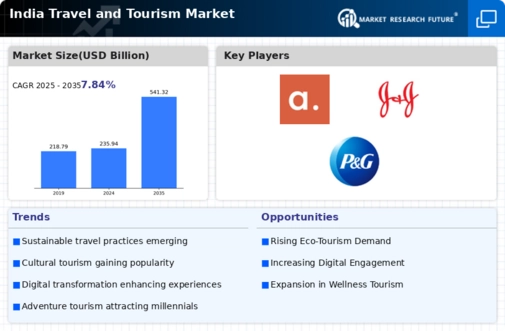Adventure and Eco-Tourism
Adventure and eco-tourism are gaining traction in the Global India Travel and Tourism Market Industry, appealing to a growing segment of travelers seeking unique experiences. With India's diverse landscapes, from the Himalayas to coastal regions, opportunities for trekking, wildlife safaris, and eco-friendly travel are abundant. This trend is particularly popular among younger travelers and international tourists who prioritize sustainable travel practices. The increasing focus on environmental conservation and responsible tourism is likely to drive growth in this segment, contributing to the overall market expansion as it aligns with the increasing demand for authentic and sustainable travel experiences.
Market Growth Projections
The Global India Travel and Tourism Market Industry is poised for substantial growth, with projections indicating a market size of 235.94 USD Billion in 2024 and an anticipated increase to 541.32 USD Billion by 2035. The compound annual growth rate (CAGR) is expected to be 7.84% from 2025 to 2035, reflecting the increasing demand for travel services and experiences. This growth trajectory is supported by various factors, including rising disposable incomes, government initiatives, and evolving consumer preferences towards adventure and cultural tourism. The market's expansion is indicative of India's potential as a leading global travel destination.
Rising Disposable Incomes
The Global India Travel and Tourism Market Industry is experiencing a notable increase in disposable incomes among the Indian middle class. As economic growth continues, more individuals are likely to allocate a portion of their income towards travel and leisure activities. This trend is particularly evident in urban areas, where the burgeoning middle class is projected to drive demand for both domestic and international travel. With disposable incomes rising, the market is expected to reach approximately 235.94 USD Billion in 2024, indicating a robust growth trajectory fueled by increased consumer spending on travel-related services.
Technological Advancements
Technological advancements play a crucial role in shaping the Global India Travel and Tourism Market Industry. The proliferation of mobile applications and online booking platforms has transformed how travelers plan and book their trips. Enhanced digital experiences, such as virtual tours and augmented reality, are increasingly appealing to tech-savvy travelers. Furthermore, the integration of artificial intelligence in customer service enhances user experience, making travel planning more efficient. These technological innovations are likely to attract a broader demographic, thereby expanding the market's reach and contributing to its projected CAGR of 7.84% from 2025 to 2035.
Cultural and Heritage Tourism
Cultural and heritage tourism is emerging as a significant driver within the Global India Travel and Tourism Market Industry. India's rich history, diverse cultures, and UNESCO World Heritage Sites attract millions of tourists annually. This segment not only appeals to international visitors but also resonates with domestic travelers seeking to explore their roots and heritage. Events like festivals and traditional fairs further enhance this appeal, creating immersive experiences for tourists. As awareness of India's cultural offerings grows, this segment is expected to contribute substantially to the market's expansion, aligning with the overall growth trajectory of the industry.
Government Initiatives and Policies
The Global India Travel and Tourism Market Industry benefits significantly from various government initiatives aimed at promoting tourism. The Indian government has implemented policies such as the e-Visa system, which simplifies the visa application process for foreign tourists. Additionally, campaigns like 'Incredible India' have been instrumental in enhancing the country's image as a travel destination. These initiatives not only attract international tourists but also encourage domestic travel, contributing to the market's growth. The government's focus on infrastructure development, including airports and roads, further supports the anticipated growth of the market, projected to reach 541.32 USD Billion by 2035.














Leave a Comment